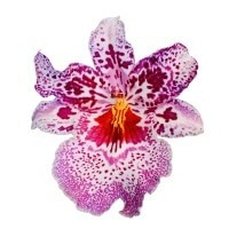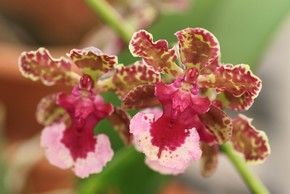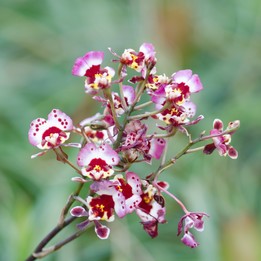Oncidiums at a Glance
Temperature: 70° – 85° F days, 50° – 65° F nights
Water: Allow to dry between watering
Light: Bright filtered light, 35 – 65% shade
Humidity: 40 – 75%
Food: Twice a month
Commonly known as “Dancing Ladies,” the broad flat lip of Oncidiums does indeed give the illusion of a ruffled lady’s skirt. There are several different sections to the Oncidium family as well as numerous closely-related families which can be used to create Oncidium intergenerics such as Colmanara, Miltassia, Burregeara and Aliceara. This means that the Oncidium alliance has something for everyone regardless of your taste or growing conditions.

Origination
These are orchids from the tropical Americas, Caribbean, Bahamas, Hispaniola and even South Florida. They grow at both sea level and in mountainous regions – as well as everywhere in between.
Flowers
Plants can be large or small and produce large or small flowers with most falling somewhere in between. Most members of the Oncidium alliance are spray-type orchids, so even species with small flowers can put on a spectacular display. Although most species bloom only once each year, many hybrids bloom three or more times.
The group of small fan-leaved Oncidiums known as Equitants (botanically known as Tolumnia) generally make side branches and continue flowering off the main flower spike, providing many weeks of continuous blooms.
Color range can be varied but is most commonly yellow or pink. What makes these orchids unique is the exotic markings and patterns that decorate many of the flowers. Some are sweetly fragrant and at least one popular hybrid has achieved some fame from its fragrance alone.
These are orchids from the tropical Americas, Caribbean, Bahamas, Hispaniola and even South Florida. They grow at both sea level and in mountainous regions – as well as everywhere in between.
Flowers
Plants can be large or small and produce large or small flowers with most falling somewhere in between. Most members of the Oncidium alliance are spray-type orchids, so even species with small flowers can put on a spectacular display. Although most species bloom only once each year, many hybrids bloom three or more times.
The group of small fan-leaved Oncidiums known as Equitants (botanically known as Tolumnia) generally make side branches and continue flowering off the main flower spike, providing many weeks of continuous blooms.
Color range can be varied but is most commonly yellow or pink. What makes these orchids unique is the exotic markings and patterns that decorate many of the flowers. Some are sweetly fragrant and at least one popular hybrid has achieved some fame from its fragrance alone.

Climate
Members of the Oncidium alliance are adaptable plants that can be easily grown in an east or west facing window in temperate areas or on a screened patio that faces south. Like all orchids, they require a certain amount of humidity and abundant air movement. Most of these orchids prefer the same intermediate temperatures as people, but being such a large diverse family, there are species that prefer a cooler climate as well as some that need warmer temperatures. Most that are commonly offered for sale however, are of the intermediate type.
Light Requirements
Most members of this family require enough light to thrive and flower reliably. Low light areas can be supplemented with grow lights if necessary.
Watering Requirements
Most oncidiums like to dry out between waterings. However, there are some, such as the fan-leaved equitants, that do not tolerate being soggy at all. This does not mean that you should not water these orchids, it just means that they need to dry out between waterings. Choice of potting material can help if you like to water your plants often. This tendency of wanting to dry out makes these carefree orchids a perfect choice for people with busy schedules.
Members of the Oncidium alliance are adaptable plants that can be easily grown in an east or west facing window in temperate areas or on a screened patio that faces south. Like all orchids, they require a certain amount of humidity and abundant air movement. Most of these orchids prefer the same intermediate temperatures as people, but being such a large diverse family, there are species that prefer a cooler climate as well as some that need warmer temperatures. Most that are commonly offered for sale however, are of the intermediate type.
Light Requirements
Most members of this family require enough light to thrive and flower reliably. Low light areas can be supplemented with grow lights if necessary.
Watering Requirements
Most oncidiums like to dry out between waterings. However, there are some, such as the fan-leaved equitants, that do not tolerate being soggy at all. This does not mean that you should not water these orchids, it just means that they need to dry out between waterings. Choice of potting material can help if you like to water your plants often. This tendency of wanting to dry out makes these carefree orchids a perfect choice for people with busy schedules.

Feeding Requirements
Feed Oncidiums every two weeks while in growth using Better-Gro® Orchid Plus® plant food. Better-Gro® Orchid Plus® contains NO urea nitrogen, only useful nitrogen and essential minor elements.
Re-potting
Better-Gro® Special Orchid™ Mix is a perfect potting media for Oncidiums and Oncidium Intergenerics in that it helps prevent overwatering. These orchids also do well in wooden slat baskets using Better-Gro® Orchid Moss for the medium. To learn more about repotting orchids, click here to watch our repotting video.
In Conclusion
Oncidiums are easy growing orchids that belong in any collection. Along with the hybrid genera Aliceara, Colmanara, Miltassia, etc., there are flowers to suit every taste. Their long-lasting flowers add a cheery note to any room of the house. If you have a bright situation in which to grow orchids, then you should certainly try orchids from the Oncidium alliance.
Feed Oncidiums every two weeks while in growth using Better-Gro® Orchid Plus® plant food. Better-Gro® Orchid Plus® contains NO urea nitrogen, only useful nitrogen and essential minor elements.
Re-potting
Better-Gro® Special Orchid™ Mix is a perfect potting media for Oncidiums and Oncidium Intergenerics in that it helps prevent overwatering. These orchids also do well in wooden slat baskets using Better-Gro® Orchid Moss for the medium. To learn more about repotting orchids, click here to watch our repotting video.
In Conclusion
Oncidiums are easy growing orchids that belong in any collection. Along with the hybrid genera Aliceara, Colmanara, Miltassia, etc., there are flowers to suit every taste. Their long-lasting flowers add a cheery note to any room of the house. If you have a bright situation in which to grow orchids, then you should certainly try orchids from the Oncidium alliance.
